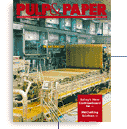Coated free-sheet: Prices improved in 1999 thanks to tighter market, higher pulp prices
GRADE STRUCTURE. Coated free-sheet papers contain less than 10% mechanical (groundwood) pulp. They comprise as many as four of the five general categories of coated papers: Nos. 1 and 2 in which there is no groundwood and No. 3, which may contain some groundwood. Nos. 4 and 5 are commonly groundwood grades but a small portion may be free-sheet (not containing groundwood pulp).
Nos. 1 and 2 generally range in basis weight from 60-100 lbs, and Nos. 3 and 4 grades from 40-90 lbs. Most coated paper (about 75% to 85%) has a glossy surface; the rest is a combination of dull, matte, and embossed. Brightness ranges from 88 for high-gloss No. 1s to 72 for less expensive, lower brightness No.4s with groundwood and chemical pulp and some clay filler. Bleached kraft hardwood pulp is used in making coated free-sheet, although some mills also use recovered paper. Coating solutions consist of pigments such as kaolin (clay), calcium carbonate or titanium dioxide and binders or adhesives (such as soluble starches).
MARKETS. In 1999, the coated free-sheet market began to recover from a difficult 1998, when prices for some grades were at their lowest in more than 10 years. Keeping prices depressed was excess capacity at U.S. paper mills, rising imports, and low pulp prices.
The market appeared to reach bottom in March 1999 and prices began to improve at mid-year, after several major producers announced a $60/ton increase on coated free-sheet printing paper grades, effective in mid-July. Producers cited a tighter market, price increases in Europe, and rising pulp prices.
Producers began implementing the increase in July but the full amount was not in place until August. No. 3 60-lb rolls were transacting at $860-$880/ton in August, up from $830-$850/ton in July and $800-$820/ton in June.
In December 1999, a second round of increases on coated free-sheet was announced for January. As of mid-month, small and medium-volume buyers reportedly were paying the full $80/ton increase. However, sources said large-volume buyers—who purchase under quarterly contracts—likely would not pay the higher price until April 1.
Many are voicing concern about a proposed 14% postal rate increase for commercial magazines that would take effect in 2001. In denouncing the proposal, the Magazine Publishers of America (MPA) told The Wall Street Journal that the hike could cost the industry $300 million.
Industry sources said the MPA likely would seek a reduction in the amount of the increase but if approved, the hike could push publishers to lighter basis weights of coated free-sheet or even to lightweight coated (LWC) groundwood papers. A source at a large magazine publisher said they likely would move from a 55-lb to a 50-lb No. 3 in the event of a postal increase. Other sources said catalog publishers might reduce the number of copies mailed or publish on the Internet.
INDUSTRY STRUCTURE AND CAPACITY. Through November 1999, U.S. coated free-sheet shipments totaled 4.7 million tons, a 2.8% increase from the year-ago period, according to the American Forest & Paper Assn. (AF&PA). According to Pulp & Paper Forecaster, U.S. producers will ship 5.3 million tons of coated free-sheet in 2000, up from an estimated 5.1 million tons in 1999.
According to the capacity report issued in December by the AF&PA, 1999 capacity was up 1.7% from the previous year and is expected to increase by 2.6% this year. During 1999-2002 coated free-sheet capacity is scheduled to rise by a total of 326,000 tons. Both North American and overseas companies cut back their expansion schedules over the last year due to market conditions.
Pulp & Paper Forecaster has predicted average operating rates of 93% and an average price of $888/ton for No. 3 60-lb rolls during 2000.
—By Nicola McIntosh News Editor




